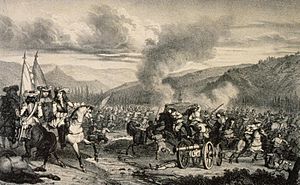Battle of Turckheim facts for kids
Quick facts for kids Battle of Turckheim |
|||||||
|---|---|---|---|---|---|---|---|
| Part of Franco-Dutch War | |||||||
 Battle of Turckheim by Emile Lemaitre |
|||||||
|
|||||||
| Belligerents | |||||||
| Commanders and leaders | |||||||
| Strength | |||||||
| 30,000 | 30,000-50,000 | ||||||
| Casualties and losses | |||||||
| 1,100 | 3,400 900 killed or wounded, 2,500 captured |
||||||
The Battle of Turckheim was an important fight during the Franco-Dutch War. It happened on January 5, 1675. The battle took place between the towns of Colmar and Turckheim in a region called Alsace, which is now part of France. In this battle, the French army, led by a skilled commander named Viscount of Turenne, won a big victory. They defeated the armies from Austria and Brandenburg, which were led by Alexander von Bournonville and Frederick William, Elector of Brandenburg.
Why the Battle Happened: A Winter Surprise
The Franco-Dutch War started in 1672. Louis XIV, the King of France, had attacked the Netherlands. This made other European countries, like Austria (which was part of the Holy Roman Empire) and Brandenburg, upset. They decided to join the fight against France.
The war then spread to the upper Rhine area, which was close to French land. In 1674, the French commander, Marshal Turenne, couldn't stop the Imperial Army from entering Alsace. As the year ended, the Imperial soldiers set up their winter camps near Colmar. The French army was camped a few miles north, in Haguenau.
Back then, armies usually stopped fighting during the winter. They would wait for spring to start battles again. But Turenne decided to do something different. He used the Vosges mountains to hide his movements. He marched his army west, then south. On December 27, 1674, he suddenly appeared in Belfort, which was south of the enemy. The Imperial forces were completely surprised. Turenne's army quickly reached Mulhouse on December 29. The surprised Imperial soldiers quickly retreated to Turckheim.
The Battle: Turenne's Clever Plan
On the afternoon of January 5, 1675, Turenne and his 30,000 soldiers faced the Imperial Army. The Imperial forces had between 30,000 and 50,000 men. They were led by Frederick William, Elector of Brandenburg and were in a strong defensive position. However, their army wasn't fully ready for a big battle.
The fight that followed was unusual for the 1600s. Turenne pretended to attack the Imperial army's middle section. Then, he faked another attack on their right side. While the enemy focused on these two areas, Turenne led about a third of his army on a secret march. They moved around to his left side, hidden by the mountains.
This hidden group quickly captured the small village of Turckheim. Frederick William tried to take the town back, but the French fired heavily with their cannons. French foot soldiers then charged, pushing the enemy back. Turenne then attacked the far right side of the Imperial army. His attack was very fast, with no warning shots from cannons. The French also had more soldiers in that spot. This sudden attack shocked the defenders. They became disorganized and scared, and many ran away. The Imperial army lost about 3,400 soldiers in total.
After the Battle: A French Victory
After the battle, the Imperial army's winter camps were no longer safe. Frederick William's army had to leave Alsace. They left about 3,000 sick or wounded soldiers in Colmar. The army then went to Strasbourg. In the next week, they crossed the Rhine River back into what is now Germany.
This short but famous winter campaign by Marshal Turenne is seen as one of the smartest military moves of the 17th century. By using two clever tricks – one big plan and one battle tactic – he saved France from being invaded. His army suffered very few losses in comparison to the enemy.

